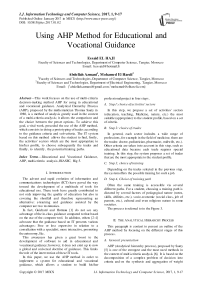Using AHP Method for Educational and Vocational Guidance
Автор: Essaid EL HAJI, Abdellah Azmani, Mohamed El Harzli
Журнал: International Journal of Information Technology and Computer Science(IJITCS) @ijitcs
Статья в выпуске: 1 Vol. 9, 2017 года.
Бесплатный доступ
This work focuses on the use of multi-criteria decision-making method AHP for using in educational and vocational guidance. Analytical Hierarchy Process (AHP), proposed by the mathematician Thomas Saaty in 1980, is a method of analysis greatly used in the context of a multi-criteria analysis; it allows the comparison and the choice between the preset options. To achieve this goal, a vital work, preceded the use of the AHP method, which consists in doing a prototyping of trades according to the guidance criteria and sub-criteria. The IT system based on this method allows the student to find, firstly, the activities' sectors which are the most appropriate to his/her profile, to choose subsequently the trades and finally, to identify, the potential training paths.
Educational and Vocational Guidance, AHP, multi-criteria analysis, RIASEC, Big 5
Короткий адрес: https://sciup.org/15012606
IDR: 15012606
Список литературы Using AHP Method for Educational and Vocational Guidance
- J. Guichard and M. Hutteau, “Psychologie de l'orientation,” 2006
- F. Rivas, “Tecnología informática en asesoramiento vocacional, Psicothema,” 2005
- S.A.I.O. – Rectorat de Versailles, “Les logiciels d’aide à l’orientation,” 2007.
- R. Chappat, “L’informatique comme aide à l’orientation, ” LE BULLETIN DE L'EPI N° 65.
- T. Saaty, “The analytic hierarchy process,” McGraw Hill, New York, 1980.
- J.M. TACNET, M. Batton-Hube and J. Deze, “Multicriteria decision analysis and information fusion for expertise applied to natural risks in mountains,” Colloque LambdaMu 17 –5-7, La Rochelle, France, Octobre 2010.
- T. Saaty, “Some mathematical concepts of the analytic hierarchy process,” Behaviormetrika 29, 1–9, 1991.
- Fouzia Ounnar, Selma Khader, Yves Dubromelle, Jean-Pierre, Prunaret, Patrick Pujo, “ Évaluation d’une méthode d’ordonnancement multicritère utilisant AHP, ”
- Noorami and all, “ Comparison of AHP and FAHP for Selecting Yard Gantry Cranes in Marine Container Terminals,” Journal of the Persian Gulf (Marine Science)/Vol. 3/No. 7, 59-70, March 2012
- S. Davies and N. Guppy, “Fields of study, college selectivity, and student inequalities in higher education,” Social Forces, 75 (4), 1417–1438, 1997.
- J. C. Simpson, “Segregated by subject: racial differences in the factors influencing academic major between European Americans, Asian Americans, and African, Hispanic, and native Americans, ” Journal of Higher Education, 72(1), 63–100, 2001.
- K.M. Galotti and Making “a Major real-life decision: college students choosing an academic major,” Journal of Educational Psychology, 91(2), 379–387, 1999.
- C. A. Coperthwaite, “The effect of self-esteem, locus of control, and background factors on college students’ choice of an academic major,” Unpublished doctoral dissertation, The University of Connecticut, Connecticut, USA, 1994.
- N. E. Betz, and P. J. Rottinghaus, Current research on parallel measures of interests and confidence for basic dimensions of vocational activity,” Journal of Career Assessment, 14(1), 56–76, 2006.
- J. W. Lounsbury, R. M. Smith, J. J. Levy, F. T. Leon and L. W. Gibson, “Personality characteristics of business majors as de fined by the Big Five and narrow personality traits, ” Journal of Education for Business, 84(4), 200–206, 2009.
- K. Leppel, “Race, Hispanic ethnicity, and the future of the college business major in the United Sates,” Journal of Education for Business, 76(4), 209–215, 2001.
- N. C. Ware, N. A. Steckler, and J. Leserman, “Undergraduate woman: who chooses a science major?,” Journal of Higher Education, 56(1), 73–84, 1985.
- D. Guglielmi, F. Fraccaroli and M. L. Pombeni, “The Professional Interests According to Holland’s Hexagonal Model Structures and Gender Difference, ” OSP, 33/3|2004, p. 409-427, 2004
- B. Stevanovic and N. Mosconi, “ Les représentations des métiers des adolescent(e-s) scolarisé(e-s) dans l’enseignement secondaire, ” Revue française de pédagogie [En ligne], 161 | octobre-décembre 2007.
- M. Lisa Larson, J. Patrick Rottinghaus, and F. H. Borgen, “Meta-analyses of Big Six Interests and Big Five Personality Factors, "Journal of Vocational Behavior 61, 217–239 (2002).
- L. R. Goldberg, “An alternative description of personality: The Big-Five factor structure,” Journal of Personality and Social Psychology, 59, 1216–1229, 1990.
- M. Ziegler, D. Bensch, U. Maaß, V. Schult, M. Vogel and M. Bühner, “ Big Five facets as predictor of job training performance: The role of specific job demands", Learning and individual Differences 29 1-7, (2014)
- Essaid, E., Abdellah, A., & Mohamed, E. A funnel model for educational and vocational guidance in using AHP method, 3rd GLOBAL CONFERENCE ON COMPUTER SCIENCE, SOFTWARE, NETWORKS AND ENGINEERING, Istanbul Aydın University, Istanbul, Turkey, 19 – 21 November 2015
- Amadou, D., Abdellah, A., & Mohamed, E. “The Choice of the Best Proposal in Tendering with AHP Method: Case of Procurement of IT Master Plan’s Realization”, I.J. Information Technology and Computer Science, 2015, 12, 1-11


